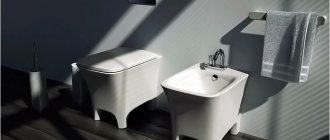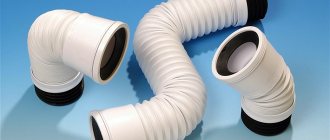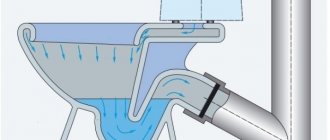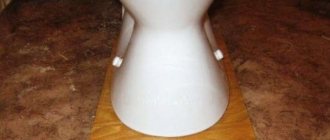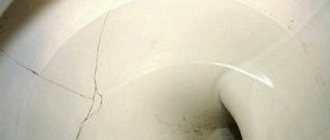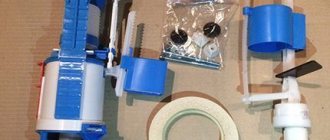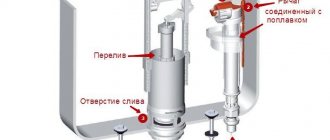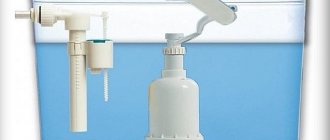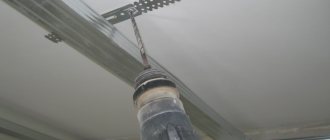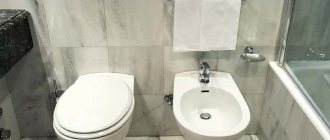Faulty plumbing causes a lot of inconvenience and is often a source of conflict with neighbors. If a toilet leaks, it spreads an unpleasant odor not only in the toilet, but throughout the entire apartment; furniture, household items, and clothes are saturated with it. Due to increased humidity in the bathroom, the floor and wall coverings are destroyed, and the ceilings of residents on the floor below are also leaking. Often the cause of a leak is poor-quality or incorrectly installed corrugation. This can happen due to the use of unskilled workers who use the cheapest materials.
In order to prevent the corrugation from leaking, it is necessary to ensure that it does not become clogged or filled with water.
Scheme of the corrugation device.
The corrugation is an accordion pipe that connects the neck of the toilet to the sewer hole. To make sure that it is not the toilet bowl (or tank) itself that is leaking, but its outlet, you just need to drain the water and see exactly where it is leaking. If the cause is, after all, corrugation, then the problem can be eliminated by repairing the tube or by replacing it. Before starting repairs, you need to find the place where the water was flowing from. There can be 2 options:
- the pipe has a rupture (or crack) and therefore flows;
- The connection of the corrugation with the sewer (or with the toilet bowl) is leaking.
Here's how to fix a folded sleeve:
- dry the crack with a hairdryer and seal it with a piece of rubber using waterproof glue;
- wrap the hole with a rag soaked in epoxy resin, having previously degreased the contact area;
- put an improvised plaster of bandage and cement mixture on the pipe;
- wrap the outlet tightly with a bandage coated with sanitary silicone.
All of the above methods will only help you forget about a leaking toilet for a while, since the corrugation is practically beyond repair.
The best solution would still be to replace the tube.
Installing corrugation on a toilet - subtleties and nuances
The process of installing a corrugation is very closely related to the installation of a toilet - you cannot install a toilet and then connect it to the sewer with a corrugation. Everything will have to be combined and done in a strictly defined sequence.
- To begin with, the corrugation must be pulled over the toilet outlet. It is very easy to put on, but nevertheless, careless movements can lead to damage to the product. If you smear the sealing rubber in the socket with soap, the corrugation will fit onto the socket easily, with minimal effort - in any case, you need to tighten it with a twist.
- Next, we move the toilet to the sewer socket and insert the corrugation into it, after which we position the pot in the desired position and mark its attachment points.
- We remove the corrugation from the sewer socket. We drill holes for fasteners in the floor and return everything to its place, inserting the corrugation into the sewer.
- Now, after a test flush, when you are convinced that there are no leaks, the toilet bowl can be thoroughly fixed to the floor. In principle, that’s all, but there is one subtlety - in order for the rubber to properly seal the connection between the corrugation and the old cast iron sewer, the socket of the latter must be very well cleaned of rust and old seal. There are no other nuances here, and you will not need any additional sealing of the seams with silicone. It is not needed here - silicone spoils the rubber over time, so you should completely forget about it.
To conclude the topic about why a toilet corrugation is needed and how it is installed, I will say a few words about replacing the old, leaky corrugation with a new one. Such repairs are carried out very simply, without even having to remove the toilet. First, squeezing the corrugation like a spring, the liner must be disconnected from the toilet. Then, accordingly, pull it out of the socket. The new corrugation is installed in the reverse order - first it is inserted into the socket, then it is compressed and pulled onto the toilet. This is where the superiority of corrugated pipes over rigid toilet connections lies. Yes, I completely forgot - such a trick is only possible if in the established position the corrugation is stretched and not compressed to the limit. This point should not be overlooked during the initial installation of a plumbing fixture.
Corrugation for toilet: advantages and disadvantages
If we compare the corrugation for a toilet flush with the old technology for connecting this plumbing fixture to the sewer system, then we can highlight at least a couple of global advantages.
- First of all, this is the speed of installation. If previously you had to wait for the sealant to harden, then in the case of a flexible outlet the toilet can be used immediately after connecting to the sewer.
- Versatility. The flexible corrugated outlet allows you to rotate the toilet bowl relative to the drain hole at almost 90 degrees in any direction. There is only one limitation for it - the outlet does not allow the toilet to be brought closer to the wall when installed directly. Well, there are other products of this type for this purpose.
- Reliability. It is ensured by a well-thought-out system of rubber seals. At such a connection, the joint leaks only in two cases - when the corrugation is installed incorrectly and when the sealing rubber dries out over time.
You can see what a corrugation for connecting a toilet is in this video.
This product also has disadvantages, which are caused not by the idea of the product itself, but by the quality of its manufacture - cheap products of this type can burst even before installation. This happens in the inept hands of a master, but it also happens due to the quality of the plastic. In general, you don’t need to buy cheap products, and everything will be fine.
Using sealant in an old bathroom
Silicone paste can be used to partially repair an old toilet whose joint with the floor has already lost its strength. To do this, proceed as follows:
- prepare the base - clean it from dirt, rust, plaque, remove old sealant if possible;
- degrease the surface;
- purchase sealant in a cartridge, insert it into a construction gun;
- pass the product over the seam so that it gets under the device as deeply as possible, making the line strictly continuous;
- remove excess composition with a rag;
- after a few minutes, start forming a seam using a rubber spatula (you can also use your hands in rubber gloves) - the goal is to level the silicone to the level of the surface being treated;
- After the drop has hardened and the seam is uneven, cut off with a utility knife.
It happens that the toilet cuff, which is placed on the sewer pipe, has lost its seal. It can also be replaced using sealant. To do this, you need to remove the adapter with the cuff from the rubber seal of the pipe, take out the latter too, clean and dry everything. Buy new parts: seal, adapter, cuff. Apply silicone sealant to the pipe, insert the rubber band, then lubricate the cuff with the same compound and secure it in place.
Corrugation for toilet installation technology
Author Anna Kmeta July 16, 2013
Few people remember that previously the entire sewer system was a cast iron structure, the main advantages of which were strength and reliability. Despite this, it had to be abandoned due to frequent pipe blockages, which could only be removed by cutting. Over time, toilets and their components have undergone many modernizations, which entailed changes in the cross-section of pipes, their length, and so on. All this led to the impossibility of using standard cast iron networks. In the modern world, not only new toilets have come to the aid of plumbers, but also their components, which are now made of plastic or rubber without sacrificing quality. One such device is a toilet corrugation. Let's consider the features of installing corrugations and their main characteristics.
What is a toilet corrugation?
A toilet corrugation is a flexible corrugated pipe that is attached to the base of the toilet flush hole and the socket of the sewer riser. It has the following features:
- inside the corrugation has an absolutely smooth surface, which prevents the accumulation of debris and, as a result, blockages;
- to increase the density of the pipe and prevent its breakthrough or cracking during casting, steel threads are used;
- high-quality corrugation for a toilet cannot cost a penny, so it is better not to skimp on this plumbing item in order to avoid unforeseen situations and frequent repairs;
- This type of plumbing pipes is perhaps the only plumbing fixture that allows you to place the toilet in the planned position, which does not always meet established standards. It often has a curved shape.
Installing a toilet corrugation
The development of a corrugated pipe has made the installation of a toilet much easier, since now there is no need to remember the dimensions of its socket and the diameter of the riser. The toilet corrugation is equipped with sealing rings that are easy to tighten to avoid leaks. So, let's look at the procedure for installing the corrugation:
- One end of the pipe must be placed on the toilet drain hole, which must first be cleared of debris. To make the connection more tight and prevent the appearance of unpleasant odors, it is recommended to lubricate it with plumbing sealant, preferably silicone. It is imperative to ensure that the pipe is evenly fixed around the entire circumference. Then you need to wait a little for the sealing solution to dry.
- Place the toilet in the place where it is planned to be placed so that it does not rock.
- The second end of the toilet corrugation must be pushed into the sewer socket until it stops, having first cleaned the pipe of dirt and coated it with sealant.
- After the silicone has dried, you need to pour several buckets of water into the toilet to control the strength of the installed corrugation. If it does not leak, there are no cracks or sagging on it, you can use the toilet.
The toilet corrugation can only be replaced if it leaks or is damaged. On average, its service life reaches 15 years.
Tips and recommendations for further care
Successful operation of sewerage in an apartment building depends on the choice of pipes. Care is related to the characteristics of the material used. Plastic is sensitive to high temperatures. For normal work at home, it is recommended that the drain temperature be 40 degrees, short-term - up to 60 degrees, otherwise the material loses its properties and the pipe may leak.
Deposits also form on smooth surfaces of PVC products. Together with the drainage of hot water, they turn the cross-section of the pipes into an ellipse, which leads to a loss of throughput. Polyvinyl chloride is a flammable material, so fire safety rules must be followed. Aggressive substances corrode the connections and walls of the corrugation; it is not recommended to drain them into the sewer.
Types of corrugations for toilet bowls, their features and purpose
Apart from variations in size, the corrugation for a toilet bowl can be classified according to only three criteria.
- According to the degree of reliability. In this regard, we can distinguish between reinforced and non-reinforced corrugation for the toilet. What is the difference between them? In short, the reinforced corrugation (in its folds) additionally contains metal wire. In more detail, this wire prevents the corrugation from bending more than necessary, and at the same time breaking in the folds. This corrugation lasts several times longer and at the same time costs only slightly more than its non-reinforced counterpart.
- According to the degree of rigidity - based on the thickness of the plastic used to make the corrugation. Despite the fact that hard corrugation is reliable and durable, soft corrugation is still widely used, since working with it is much easier and more convenient.
- According to the direction of the bell. In this regard, three more variants of products of this type can be distinguished - corrugation with a straight bell, bent at 90 and 45 degrees. The first is considered universal. The second allows you to connect a direct-outlet toilet to a drain coming out of the floor. And the third is mainly used to connect the toilet to a horizontal sewer pipe located low above the floor. In general, these varieties are designed for various situations and none of them are completely universal, no matter how much one would like it.
All these points, or rather varieties, must certainly be taken into account when choosing corrugation - or rather, they must be correlated with local circumstances, on the basis of which the choice of one or another variety of corrugation is made
Particular attention should be paid to the length of the product - in the sense that you should not purchase a short corrugation in the hope that it will stretch. It may stretch, but then it can just as easily shrink back, forming a leak.
Everything should be in moderation.
Toilet leaking causes and solutions
If water is leaking in the toilet, then the problem needs to be fixed as soon as possible, since constantly leaking water can cause flooding of your apartment and the apartment of your neighbors living below. All repair work can be done independently.
Plumbing product malfunctions
The main causes of leakage
If water appears on the floor of the toilet room, the reasons may be:
- wear of the gasket installed between the toilet bowl and the flush cistern;
- worn gaskets on the fastening elements of the tank;
- loosening of the threaded connection between the inlet and the float valve located in the drain tank;
- rupture or displacement of the corrugated hose connecting the toilet outlet to the sewer pipe.
Methods for eliminating leaks
How to fix a toilet leak? First of all, it is necessary to find out what caused the puddle to form. To do this, simply drain the water in the toilet and visually determine the location of the leak. If you can’t determine it visually, you can feel each element of the system with your hands. Moisture will appear at the leak site.
Replacing the gasket between the bowl and the tank
If the toilet runs, but no chips or cracks are found on the flush cistern during a visual inspection, then the reason lies in the wear of the gasket located between the toilet bowl and the cistern. Troubleshooting occurs according to the following scheme:
- the water supply to the toilet is cut off;
- The water is completely drained from the cistern. It is recommended to remove any remaining water with a cloth;
- the hose supplying water to the tank is disconnected;
Disconnecting the line from the toilet tank
- the bolts securing the tank are loosened;
The junction of the inlet fittings with the drain tank
This is a fairly common problem in which the toilet leaks from below. It is often confused with the formation of condensation on the surface of the tank.
Important! If the leak is not eliminated for a long time, a dark smudge forms at the junction.
How to fix the problem:
- Using a wrench, tighten the inlet fitting nut to the tank if the reason is a loose gasket.
Important! This is especially true for tanks with a bottom supply.
- If the gasket is completely missing or worn out, turn off the water and disconnect the nut with the hose. Buy the same gasket that was installed and replace it.
- In tanks with side inlet, leakage occurs from improper adjustment of the shut-off valve. Because of this, the water level in the tank is too high. Open the tank lid, then tighten the fixing screw and lower the float a little. The water will thus be shut off before it reaches a critical level.
Important! While working on the float, also check the condition of the sealing gasket. If necessary, replace it with a new one.
- Fuzzy operation of the diaphragm valve due to errors in the assembly of water intake fittings. Simply dismantle the fittings and check the condition of all threaded connections.
- Worn diaphragm valve. This malfunction can be eliminated by completely replacing the shut-off valves. On average, the replacement frequency is 1 time every 5 years.
